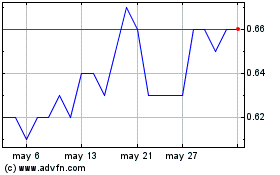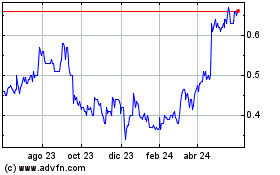Reunion Gold Corporation (TSX-V: RGD) (the “Company”) is pleased to
provide an update on ongoing exploration activities on projects in
Guyana, which are part of the Strategic Alliance with Barrick Gold
Corporation.
All projects are in the Cuyuni River basin in
Northwest Guyana, the largest gold producing region in the country
(Figure 1). This region is underlain by strongly deformed
“greenstone belts” of Proterozoic age composed of volcanic and
sedimentary rocks intruded by granitic plutons, forming an ideal
environment for the creation of orogenic gold deposits.
Waiamu Project
Most of the exploration work completed by the
Company in Guyana has been conducted on the Waiamu Project. A
comprehensive exploration program of regolith geochemical sampling,
geological mapping, trenching and drilling covering the 150 km²
eastern half of the project area was carried out (Figures 2 and 3).
The work done so far has identified a NE-trending sequence of
mostly clastic sediments intercalated with mafic volcanic flows and
a distinct doleritic sill, in which gold mineralization aligns
closely with two sets of shear zones (Figure 2).
Geochemical sampling identified numerous zones
of anomalous gold within the central volcanic-dominated domain on
the project area and a subsequent detailed heliborne magnetic and
radiometric surveys showed that these anomalous zones coincided
with several structures (shears) which were then targeted for
follow-up. The follow up work included over 7,800 meters of trench
sampling over eight of the targets to date, and 4,050 meters of
diamond drilling on two artisanal mining prospects, Ceguinho and
St. John, as well as the W14 target area (Figures 2 and 3). Tables
1 and 2 show the best intersections from trenching and drilling,
with several significant gold-mineralized zones. These zones are
usually associated with strongly hydrothermally altered and sheared
rocks.
Waiamu Project - Next steps and upcoming
drill program
The objective of the 2019 exploration program
has been to generate and test by trenching as many targets as
possible. The prioritizing of targets is based on a comprehensive
review of their associated geological, geochemical and geophysical
anomalies. The Company has recently commenced an 80 line-km
gradient array induced polarization geophysical survey over six of
the current targets (Figure 3). Given the observed association of
gold mineralization with sulphides in drill core, several new drill
targets are expected to be generated from the current exploration
area, and a follow-up drill program is being planned for the first
quarter of 2020.
The western half block of the project area, also
referred as Kartuni, is being covered by a detailed fixed-wing
magnetic and radiometric survey, to be followed by stream sediment
and regolith geochemical sampling and geological mapping in
2020.
Réjean Gourde, the Company’s CEO, stated: “Our
work to date at Waiamu has demonstrated the presence of several
widely mineralized gold targets. An ongoing review of the data is
expected to soon generate new drill targets, which we plan to test
early in the new year.”
Other Projects
Stream sediment sampling and geological mapping
programs have been completed at the Aremu and Oko projects in
October. A detailed fixed-wing magnetic and radiometric survey is
planned to be completed on both projects in November. The Company
expects to carry out comprehensive follow-up regolith geochemical
sampling and trenching of targets early in 2020. The project areas
are easily accessible by road and river, which facilitates the
mobilization of trenching and drilling equipment.
The Aremu project area is at the confluence of
the Aremu and Cuyuni rivers, where more than 15 km² of alluvial and
primary gold mineralization has been artisanally mined for decades
along the contact of a granitic intrusive and mafic volcanic
rocks.
The Oko project area is about 20 km to the
southwest of Aremu, underlain mostly by mafic volcanic and clastic
sedimentary rocks cut by a gabbroic intrusive and the western edge
of the Bartica granitic complex. The area has extensive artisanal
gold production and numerous pits and shafts done on mineralized
quartz vein swarms.
Quality assurance and quality
control
The Company has implemented a quality assurance
and quality control (QA/QC) program and chain of custody protocols
for all its sampling programs. Trench samples are collected along
continuous sub-horizontal hand-dug channels usually 1 to 2 m long,
10 cm wide and deep. Core drilling uses HQ‐size rods in saprolite
and NQ‐size rods in fresh rock with half‐core samples collected.
Sample length in core is usually 1.0 meter but varies according to
geological contacts. Certified standards and blanks are inserted
regularly and comprise approximately 10% of the number of total
samples assayed. Samples are dried, crushed to 80% passing 2 mm,
riffle split (250 g) and pulverized to 95% passing 105 microns and
then analyzed for gold by fire assay with atomic absorption finish
on 50‐gram pulps. Samples above 3 g/t gold are systematically
re‐analyzed with gravimetry finish. All analysis are performed by
Actlabs Guyana, an accredited laboratory according to ISO
9001(2015), IAF and ANAB, holding the TRC number 01033.
Qualified Person
Carlos H. Bertoni, P. Geo., a consultant to the
Company and a qualified person pursuant to National Instrument
43-101, has reviewed and approved the scientific and technical data
contained in this press release.
Cautionary Statement
This press release contains certain
forward-looking information or forward-looking statements as
defined in applicable securities laws. Forward-looking statements
are not historical facts and are subject to several risks and
uncertainties beyond the Company’s control, including statements
regarding plans to complete drilling and other exploration program,
potential mineralization, exploration results and statements
regarding beliefs, plans, expectations or intentions of the
Company. Resource exploration and development is highly
speculative, characterized by several significant risks, which even
a combination of careful evaluation, experience and knowledge may
not eliminate. Such risks include but are not limited to:
uncertainties regarding the availability of funds to conduct plan
exploration programs and for additional capital requirements,
uncertainty of exploration results; misinterpretation of data,
logistical problems, volatility of gold price; mining risks,
uncertainties related to the Company’s ability to acquire the
Guyana Projects; and cost of exploration and development programs.
All forward-looking statements herein are qualified by this
cautionary statement. Accordingly, readers should not place undue
reliance on forward-looking statements. The Company undertakes no
obligation to update publicly or otherwise revise any
forward-looking statements whether as a result of new information
or future events or otherwise, except as may be required by
law.
Neither the TSX Venture Exchange nor its
Regulation Services Provider (as that term is defined in the
policies of the TSX Venture Exchange) accepts responsibility for
the adequacy or accuracy of this press release.
About Reunion Gold
Reunion Gold Corporation is a Canadian
exploration company focused on acquiring, exploring and developing
gold projects in the Guiana Shield, South America. The Company has
entered into option agreements to acquire an interest in the
Boulanger, Dorlin and Haute Mana projects in French Guiana and in
the Waiamu, Aremu, Oko and Arawini projects in Guyana.
The Company’s shares are listed on the TSX
Venture Exchange under the symbol ‘RGD’. Additional information
about the Company is available on SEDAR (www.sedar.com) and on the
Company’s website (www.reuniongold.com). For further information
please contact:
REUNION GOLD CORPORATION Réjean
Gourde, President & CEOTelephone: +1 450.677.2585Email:
info@reuniongold.com
Figure 1 - Geology map of NW Guyana showing
locations of Reunion Gold projects.
Figure 2 - Map of the eastern Waiamu
project area showing regolith geochemistry anomalies and
interpreted surface geology with current exploration targets.
Figure 3 - Map of the eastern-central
part of the Waiamu project area, showing current targets and
location of trenching / diamond drilling, underlain by magnetic
anomalies.
Table 1 - Waiamu Project Trench
channel sampling intersections.
Table 2 - Waiamu Project Diamond
drill intersections.
Reunion Gold (TSXV:RGD)
Gráfica de Acción Histórica
De Dic 2024 a Ene 2025

Reunion Gold (TSXV:RGD)
Gráfica de Acción Histórica
De Ene 2024 a Ene 2025
